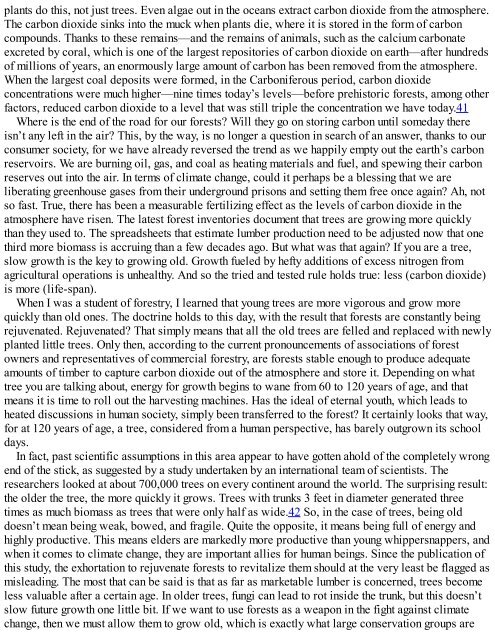You also want an ePaper? Increase the reach of your titles
YUMPU automatically turns print PDFs into web optimized ePapers that Google loves.
plants do this, not just trees. Even algae out in the oceans extract carbon dioxide from the atmosphere.<br />
<strong>The</strong> carbon dioxide sinks into the muck when plants die, where it is stored in the form <strong>of</strong> carbon<br />
compounds. Thanks to these remains—and the remains <strong>of</strong> animals, such as the calcium carbonate<br />
excreted by coral, which is one <strong>of</strong> the largest repositories <strong>of</strong> carbon dioxide on earth—after hundreds<br />
<strong>of</strong> millions <strong>of</strong> years, an enormously large amount <strong>of</strong> carbon has been removed from the atmosphere.<br />
When the largest coal deposits were formed, in the Carboniferous period, carbon dioxide<br />
concentrations were much higher—nine times today’s levels—before prehistoric forests, among other<br />
factors, reduced carbon dioxide to a level that was still triple the concentration we have today.41<br />
Where is the end <strong>of</strong> the road for our forests? Will they go on storing carbon until someday there<br />
isn’t any left in the air? This, by the way, is no longer a question in search <strong>of</strong> an answer, thanks to our<br />
consumer society, for we have already reversed the trend as we happily empty out the earth’s carbon<br />
reservoirs. We are burning oil, gas, and coal as heating materials and fuel, and spewing their carbon<br />
reserves out into the air. In terms <strong>of</strong> climate change, could it perhaps be a blessing that we are<br />
liberating greenhouse gases from their underground prisons and setting them free once again? Ah, not<br />
so fast. True, there has been a measurable fertilizing effect as the levels <strong>of</strong> carbon dioxide in the<br />
atmosphere have risen. <strong>The</strong> latest forest inventories document that trees are growing more quickly<br />
than they used to. <strong>The</strong> spreadsheets that estimate lumber production need to be adjusted now that one<br />
third more biomass is accruing than a few decades ago. But what was that again? If you are a tree,<br />
slow growth is the key to growing old. Growth fueled by hefty additions <strong>of</strong> excess nitrogen from<br />
agricultural operations is unhealthy. And so the tried and tested rule holds true: less (carbon dioxide)<br />
is more (life-span).<br />
When I was a student <strong>of</strong> forestry, I learned that young trees are more vigorous and grow more<br />
quickly than old ones. <strong>The</strong> doctrine holds to this day, with the result that forests are constantly being<br />
rejuvenated. Rejuvenated? That simply means that all the old trees are felled and replaced with newly<br />
planted little trees. Only then, according to the current pronouncements <strong>of</strong> associations <strong>of</strong> forest<br />
owners and representatives <strong>of</strong> commercial forestry, are forests stable enough to produce adequate<br />
amounts <strong>of</strong> timber to capture carbon dioxide out <strong>of</strong> the atmosphere and store it. Depending on what<br />
tree you are talking about, energy for growth begins to wane from 60 to 120 years <strong>of</strong> age, and that<br />
means it is time to roll out the harvesting machines. Has the ideal <strong>of</strong> eternal youth, which leads to<br />
heated discussions in human society, simply been transferred to the forest? It certainly looks that way,<br />
for at 120 years <strong>of</strong> age, a tree, considered from a human perspective, has barely outgrown its school<br />
days.<br />
In fact, past scientific assumptions in this area appear to have gotten ahold <strong>of</strong> the completely wrong<br />
end <strong>of</strong> the stick, as suggested by a study undertaken by an international team <strong>of</strong> scientists. <strong>The</strong><br />
researchers looked at about 700,000 trees on every continent around the world. <strong>The</strong> surprising result:<br />
the older the tree, the more quickly it grows. <strong>Trees</strong> with trunks 3 feet in diameter generated three<br />
times as much biomass as trees that were only half as wide.42 So, in the case <strong>of</strong> trees, being old<br />
doesn’t mean being weak, bowed, and fragile. Quite the opposite, it means being full <strong>of</strong> energy and<br />
highly productive. This means elders are markedly more productive than young whippersnappers, and<br />
when it comes to climate change, they are important allies for human beings. Since the publication <strong>of</strong><br />
this study, the exhortation to rejuvenate forests to revitalize them should at the very least be flagged as<br />
misleading. <strong>The</strong> most that can be said is that as far as marketable lumber is concerned, trees become<br />
less valuable after a certain age. In older trees, fungi can lead to rot inside the trunk, but this doesn’t<br />
slow future growth one little bit. If we want to use forests as a weapon in the fight against climate<br />
change, then we must allow them to grow old, which is exactly what large conservation groups are
















